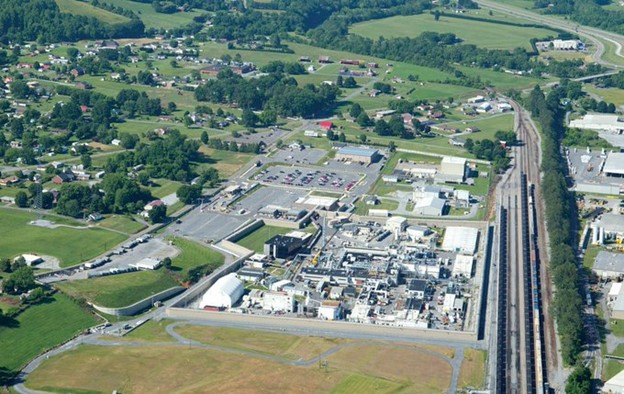The IAEA’s new nuclear security training center. (Photo: Katy Laffan/IAEA)
K-9 officer Dee and her partner, Patrol Officer Manny Rodriguez, during a training exercise. (Photo: DOE )
The Department of Energy’s Hanford Site has introduced its newest team members, Dee and Freda, two highly skilled explosive-detecting K-9 officers. The police dogs will work with Richland Operations Office contractor Hanford Mission Integration Solutions to help ensure the safety and security of the legacy nuclear reservation near Richland, Wash.
NNSA administrator Jill Hruby surveys the Administrative Boundary Line at South Ossetia. Russia occupies Georgian territory on the other side of the line. (Photo: NNSA)
National Nuclear Security Administration administrator Jill Hruby and deputy administrator for defense nuclear nonproliferation Corey Hinderstein visited the country of Georgia in southeastern Europe last month to discuss the NNSA’s bilateral partnerships, seek areas of cooperation, and get a closer look at how nuclear security is implemented at active border crossings in the region.
Nuclear Fuel Services in Erwin, Tenn. (Photo: BWX Technologies)
BWX Technologies announced on April 10 that its Nuclear Fuel Services subsidiary in Erwin, Tenn., has been awarded a five-year, $428 million contract from the National Nuclear Security Administration to purify and convert high-enriched uranium (HEU) from an oxide to a metal. The Phase II contract follows the successful completion by NFS of a $57.5 million contract awarded two years ago for a process line design and pilot demonstration.
The DOE's Savannah River Site. (Photo: DOE)
The Defense Nuclear Facilities Safety Board (DNFSB) is scheduled to visit the Department of Energy’s Savannah River Site in South Carolina the week of May 8 to discuss ongoing safety concerns and the protection of the public and workforce, as well as the DOE’s effectiveness in addressing those concerns.
The Y-12 site in Oak Ridge, Tenn. (Photo: Wikimedia Commons)
A fire broke out at the Y-12 National Security Complex in Oak Ridge, Tenn., earlier today. According to Y-12’s Facebook page, one of the site’s production buildings had a fire in a hood at approximately 9:15 a.m. Y-12 emergency services responded to the event and precautionary protective actions were initiated for employees who were in the vicinity of the incident and who were not involved in the emergency response.
The Zaporizhzhia plant (Image: Energoatom)
As if being stuck in the middle of a combat zone isn’t sufficiently nerve-racking, workers at Ukraine’s Zaporizhzhia nuclear power plant—under Russian occupation since last March—must now concern themselves with having access to enough water to keep the facility safe.
A crane is used to remove equipment during a project to repurpose Building 226-F for an NNSA mission at the Savannah River Site. (Photo: DOE)
Work has begun to prepare the Savannah River Plutonium Processing Facility (SRPPF) at the Department of Energy’s Savannah River Site in South Carolina for its future national security mission: the manufacturing of plutonium pits for the National Nuclear Security Administration.
The Rivne nuclear power plant in western Ukraine, home to four VVER pressurized water reactors. (Photo: Victor Korniyenko/Wikipedia)
In what it is calling a “major expansion” of its efforts to prevent a severe nuclear accident befalling Ukraine, the International Atomic Energy Agency yesterday announced that it is deploying teams of nuclear security and safety experts this week to the beleaguered nation’s nuclear power plants and the Chernobyl site. (The agency has already stationed a team of experts at Ukraine’s largest nuclear facility, the six-unit Zaporizhzhia plant, which has been under Russian military occupation since last March.)
This image from a video reportedly shows the start of installation of a protective covering over spent fuel storage tanks at the Zaporizhzhia nuclear power plant in Ukraine. (Image: Telegram/Vladimir Rogov)
Russia has begun construction of protected covering at Ukraine’s Zaporizhzhia nuclear power plant, according to a December 17 report from Russian news outlet RT. The story has been picked up in the West by some news agencies but has not been widely circulated.
Vladimir Rogov, a Russian-appointed official in Zaporizhzhia Oblast, said, “Russia is constructing a protective dome over spent radioactive fuel stores at the [Zaporizhzhia] nuclear power plant as Ukrainian forces continue to target the facility.”
Kerekes leans on the original vehicle recognition system hardware, which required the large solar panels behind him to power it. Kerekes holds the current version, which has been greatly reduced in size from its predecessor. (Photo: Carlos Jones/DOE)
A technology developed to prevent poachers from killing endangered African species is being adapted by researchers at Oak Ridge National Laboratory to recognize individual motor vehicles. The capability could help secure checkpoints and track nuclear materials, among other uses.














